Abstract
Heat-killed Streptococcus mutans was administered orally in two periods of 1 week to six subjects in an attempt to affect the salivary immunoglobulin A (IgA) response to this bacterium. Enzyme-linked immunosorbent assays were used to detect specific IgA antibody activity, and an immunofluorescent assay was used for measurement of total IgA in parotid saliva. The salivary IgA response to S. mutans was compared with that against a noncross-reacting antigen preparation from Escherichia coli and with antibody responses in five sham-immunized subjects. No change in salivary IgA response to S. mutans was observed after oral administration of this organism. Significantly less streptomycin-resistant S. mutans could be recovered from the six test subjects than from the five controls after the first of two challenges with streptomycin-resistant microorganisms. At the day of the first challenge, a significantly higher IgA antibody response to all tested antigens was observed in the test group than in the control group. The data show that this difference was not related to the oral administration of S. mutans but rather was an occasional finding. The coincidence of a rapid elimination of the challenge strain and a high IgA antibody response to S. mutans supports the concept that salivary IgA antibodies could have a biological significance in the human defense against cariogenic microorganisms.
Full text
PDF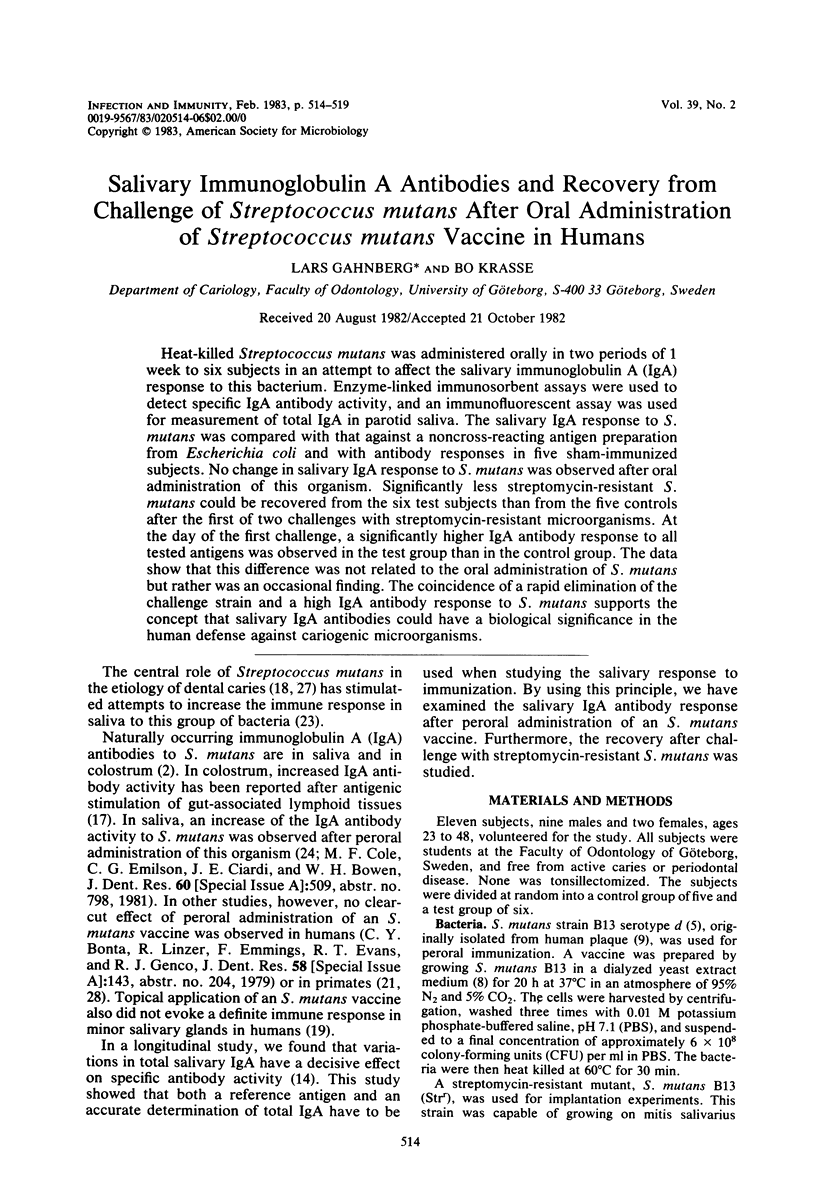
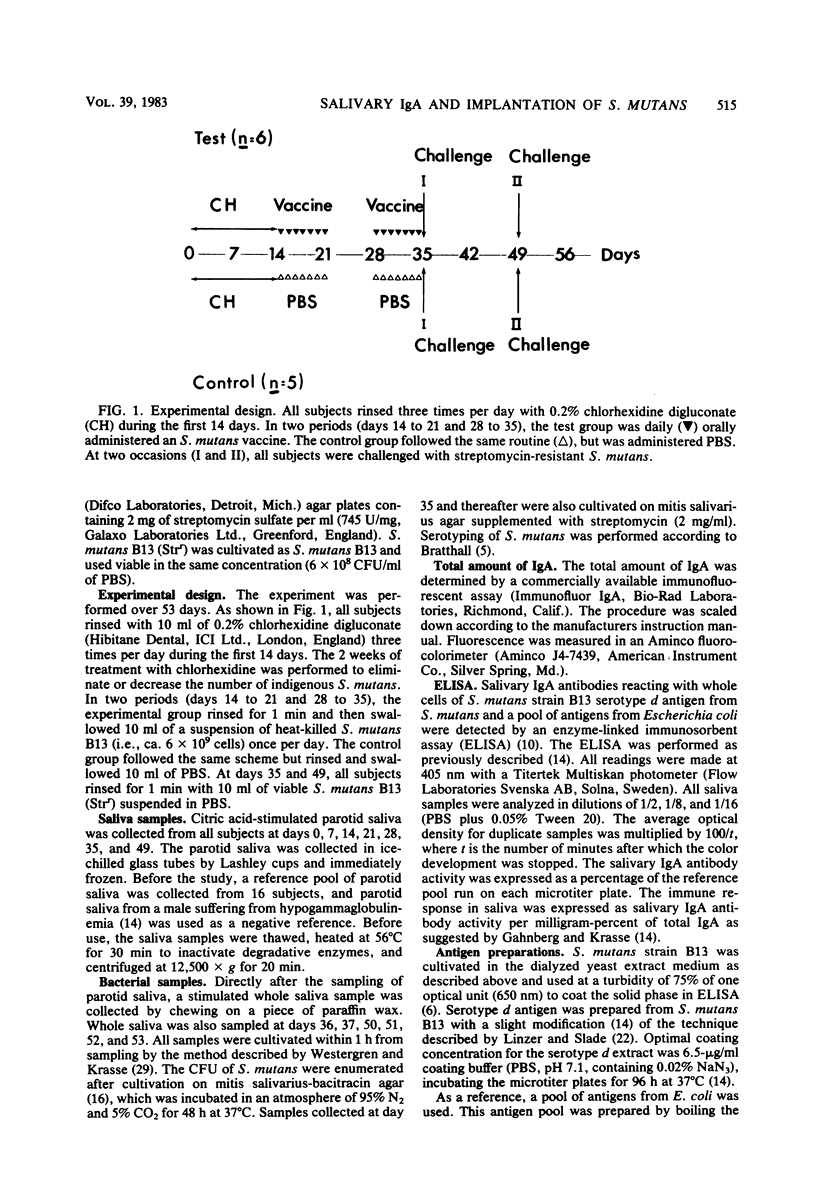
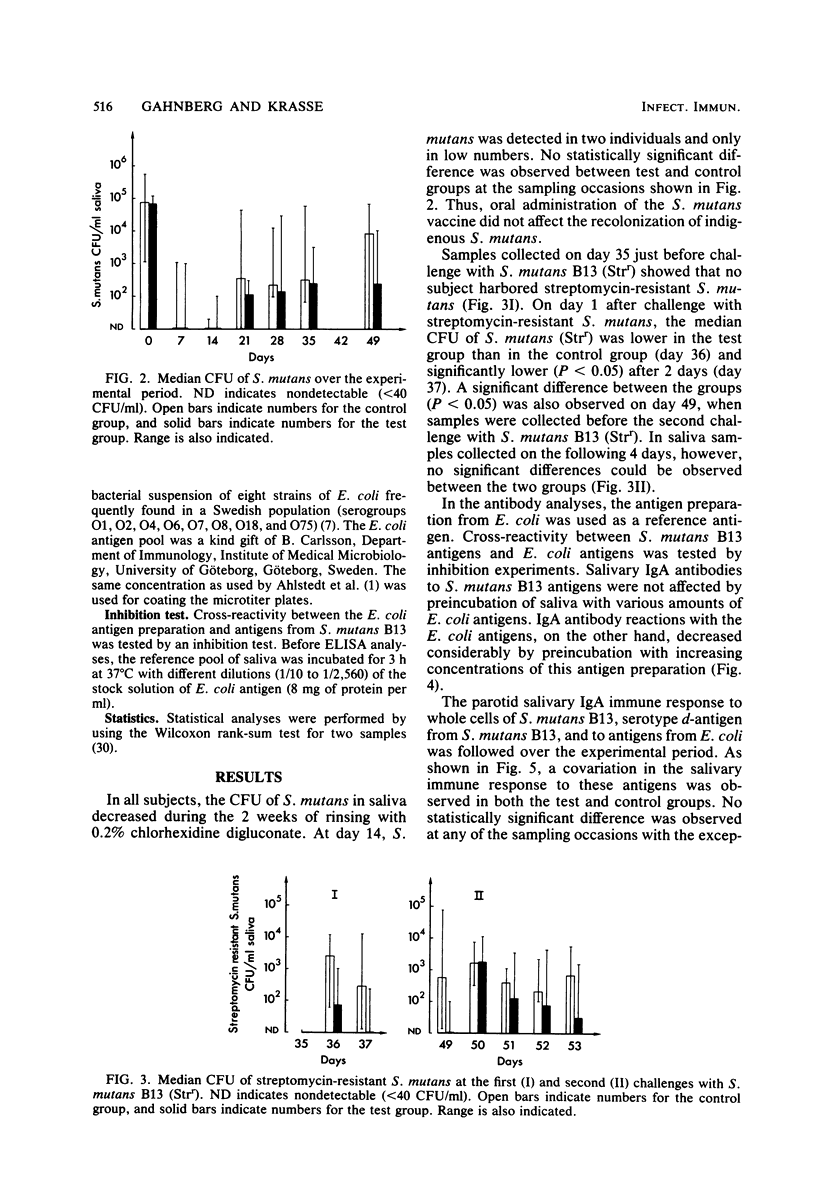
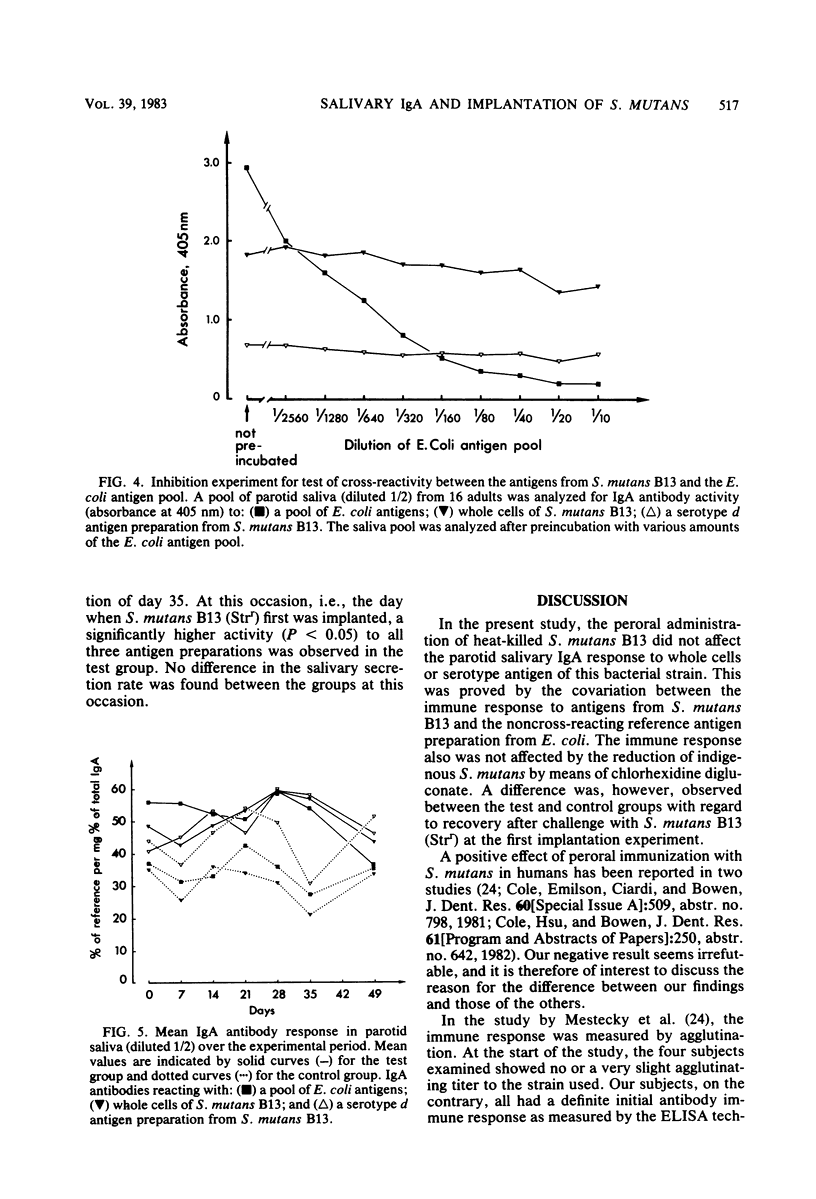
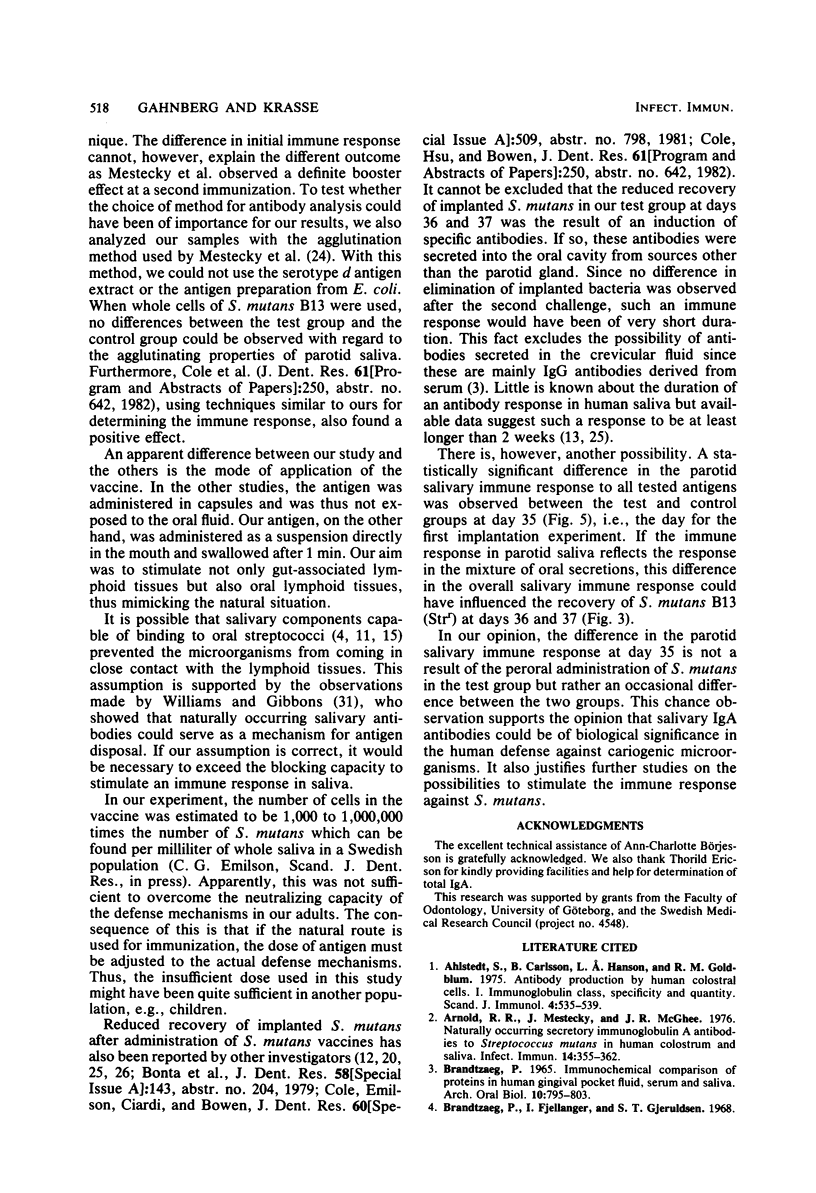
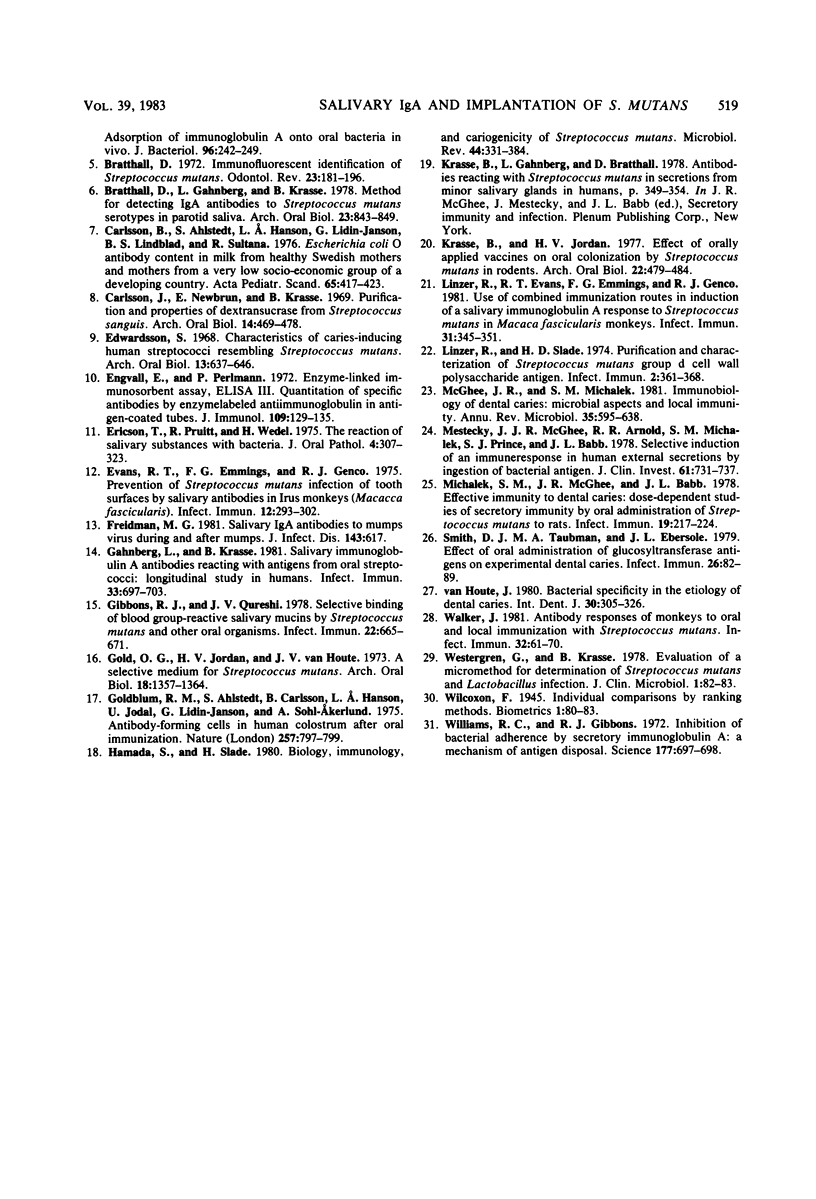
Selected References
These references are in PubMed. This may not be the complete list of references from this article.
- Ahlstedt S., Carlsson B., Hanson L. A., Goldblum R. M. Antibody production by human colostral cells. I. Immunoglobulin class, specificity, and quantity. Scand J Immunol. 1975 Sep;4(5-6):535–539. doi: 10.1111/j.1365-3083.1975.tb02659.x. [DOI] [PubMed] [Google Scholar]
- Arnold R. R., Mestecky J., McGhee J. R. Naturally occurring secretory immunoglobulin A antibodies to Streptococcus mutans in human colostrum and saliva. Infect Immun. 1976 Aug;14(2):355–362. doi: 10.1128/iai.14.2.355-362.1976. [DOI] [PMC free article] [PubMed] [Google Scholar]
- Brandtzaeg P., Fjellanger I., Gjeruldsen S. T. Adsorption of immunolgobulin A onto oral bacteria in vivo. J Bacteriol. 1968 Jul;96(1):242–249. doi: 10.1128/jb.96.1.242-249.1968. [DOI] [PMC free article] [PubMed] [Google Scholar]
- Brandtzaeg P. Immunochemical comparison of proteins in human gingival pocket fluid, serum and saliva. Arch Oral Biol. 1965 Sep-Oct;10(5):796–803. doi: 10.1016/0003-9969(65)90133-0. [DOI] [PubMed] [Google Scholar]
- Bratthall D., Gahnberg L., Krasse B. Method for detecting IgA antibodies to Streptococcus mutans serotypes in parotid saliva. Arch Oral Biol. 1978;23(10):843–849. doi: 10.1016/0003-9969(78)90285-6. [DOI] [PubMed] [Google Scholar]
- Bratthall D. Immunofluorescent identification of Streptococcus mutans. Odontol Revy. 1972;23(2):181–196. [PubMed] [Google Scholar]
- Carlsson B., Ahlstedt S., Hanson L. A., Lidin-Janson G., Lindblad B. S., Sultana R. Escherichia coli O antibody content in milk from healthy Swedish mothers and mothers from a very low socio-economic group of a developing country. Acta Paediatr Scand. 1976 Jul;65(4):417–423. doi: 10.1111/j.1651-2227.1976.tb04908.x. [DOI] [PubMed] [Google Scholar]
- Carlsson J., Newbrun E., Krasse B. Purification and properties of dextransucrase from Streptococcus sanguis. Arch Oral Biol. 1969 May;14(5):469–478. doi: 10.1016/0003-9969(69)90140-x. [DOI] [PubMed] [Google Scholar]
- Edwardsson S. Characteristics of caries-inducing human streptococci resembling Streptococcus mutans. Arch Oral Biol. 1968 Jun;13(6):637–646. doi: 10.1016/0003-9969(68)90142-8. [DOI] [PubMed] [Google Scholar]
- Engvall E., Perlmann P. Enzyme-linked immunosorbent assay, Elisa. 3. Quantitation of specific antibodies by enzyme-labeled anti-immunoglobulin in antigen-coated tubes. J Immunol. 1972 Jul;109(1):129–135. [PubMed] [Google Scholar]
- Ericson T., Pruitt K., Wedel H. The reaction of salivary substances with bacteria. J Oral Pathol. 1975 Dec;4(6):307–323. doi: 10.1111/j.1600-0714.1975.tb01748.x. [DOI] [PubMed] [Google Scholar]
- Evans R. T., Emmings F. G., Genco R. J. Prevention of Streptococcus mutans infection of tooth surfaces by salivary antibody in Irus monkeys (Macaca fascicularis). Infect Immun. 1975 Aug;12(2):293–302. doi: 10.1128/iai.12.2.293-302.1975. [DOI] [PMC free article] [PubMed] [Google Scholar]
- Friedman M. G. Salivary IgA antibodies to mumps virus during and after mumps. J Infect Dis. 1981 Apr;143(4):617–617. doi: 10.1093/infdis/143.4.617. [DOI] [PubMed] [Google Scholar]
- Gahnberg L., Krasse B. Salivary immunoglobulin A antibodies reacting with antigens from oral streptococci: longitudinal study in humans. Infect Immun. 1981 Sep;33(3):697–703. doi: 10.1128/iai.33.3.697-703.1981. [DOI] [PMC free article] [PubMed] [Google Scholar]
- Gibbons R. J., Qureshi J. V. Selective binding of blood group-reactive salivary mucins by Streptococcus mutans and other oral organisms. Infect Immun. 1978 Dec;22(3):665–671. doi: 10.1128/iai.22.3.665-671.1978. [DOI] [PMC free article] [PubMed] [Google Scholar]
- Gold O. G., Jordan H. V., Van Houte J. A selective medium for Streptococcus mutans. Arch Oral Biol. 1973 Nov;18(11):1357–1364. doi: 10.1016/0003-9969(73)90109-x. [DOI] [PubMed] [Google Scholar]
- Goldblum R. M., Ahlstedt S., Carlsson B., Hanson L. A., Jodal U., Lidin-Janson G., Sohl-Akerlund A. Antibody-forming cells in human colostrum after oral immunisation. Nature. 1975 Oct 30;257(5529):797–798. doi: 10.1038/257797a0. [DOI] [PubMed] [Google Scholar]
- Hamada S., Slade H. D. Biology, immunology, and cariogenicity of Streptococcus mutans. Microbiol Rev. 1980 Jun;44(2):331–384. doi: 10.1128/mr.44.2.331-384.1980. [DOI] [PMC free article] [PubMed] [Google Scholar]
- Krasse B., Gahnberg L., Bratthall D. Antibodies reacting with Streptococcus mutans in secretions from minor salivary glands in humans. Adv Exp Med Biol. 1978;107:349–354. doi: 10.1007/978-1-4684-3369-2_40. [DOI] [PubMed] [Google Scholar]
- Krasse B., Jordan H. V. Effect of orally applied vaccines on oral colonization by Streptococcus mutans in rodents. Arch Oral Biol. 1977;22(8-9):479–484. doi: 10.1016/0003-9969(77)90041-3. [DOI] [PubMed] [Google Scholar]
- Linzer R., Evans R. T., Emmings F. G., Genco R. J. Use of combined immunization routes in induction of a salivary immunoglobulin A response to Streptococcus mutans in Macaca fascicularis monkeys. Infect Immun. 1981 Jan;31(1):345–351. doi: 10.1128/iai.31.1.345-351.1981. [DOI] [PMC free article] [PubMed] [Google Scholar]
- Linzer R., Slade H. D. Purification and characterization of Streptococcus mutans group d cell wall polysaccharide antigen. Infect Immun. 1974 Aug;10(2):361–368. doi: 10.1128/iai.10.2.361-368.1974. [DOI] [PMC free article] [PubMed] [Google Scholar]
- McGhee J. R., Michalek S. M. Immunobiology of dental caries: microbial aspects and local immunity. Annu Rev Microbiol. 1981;35:595–638. doi: 10.1146/annurev.mi.35.100181.003115. [DOI] [PubMed] [Google Scholar]
- Mestecky J., McGhee J. R., Arnold R. R., Michalek S. M., Prince S. J., Babb J. L. Selective induction of an immune response in human external secretions by ingestion of bacterial antigen. J Clin Invest. 1978 Mar;61(3):731–737. doi: 10.1172/JCI108986. [DOI] [PMC free article] [PubMed] [Google Scholar]
- Michalek S. M., McGhee J. R., Babb J. L. Effective immunity to dental caries: dose-dependent studies of secretory immunity by oral administration of Streptococcus mutans to rats. Infect Immun. 1978 Jan;19(1):217–224. doi: 10.1128/iai.19.1.217-224.1978. [DOI] [PMC free article] [PubMed] [Google Scholar]
- Smith D. J., Taubman M. A., Ebersole J. L. Effect of oral administration of glucosyltransferase antigens on experimental dental caries. Infect Immun. 1979 Oct;26(1):82–89. doi: 10.1128/iai.26.1.82-89.1979. [DOI] [PMC free article] [PubMed] [Google Scholar]
- Walker J. Antibody responses of monkeys to oral and local immunization with Streptococcus mutans. Infect Immun. 1981 Jan;31(1):61–70. doi: 10.1128/iai.31.1.61-70.1981. [DOI] [PMC free article] [PubMed] [Google Scholar]
- Westergren G., Krasse B. Evaluation of a micromethod for determination of Streptococcus mutans and Lactobacillus infection. J Clin Microbiol. 1978 Jan;7(1):82–83. doi: 10.1128/jcm.7.1.82-83.1978. [DOI] [PMC free article] [PubMed] [Google Scholar]
- Williams R. C., Gibbons R. J. Inhibition of bacterial adherence by secretory immunoglobulin A: a mechanism of antigen disposal. Science. 1972 Aug 25;177(4050):697–699. doi: 10.1126/science.177.4050.697. [DOI] [PubMed] [Google Scholar]
- van Houte J. Bacterial specificity in the etiology of dental caries. Int Dent J. 1980 Dec;30(4):305–326. [PubMed] [Google Scholar]


